《英语教学法》Unit-11-Teaching-ReadingPPT课件
- 格式:ppt
- 大小:480.00 KB
- 文档页数:7
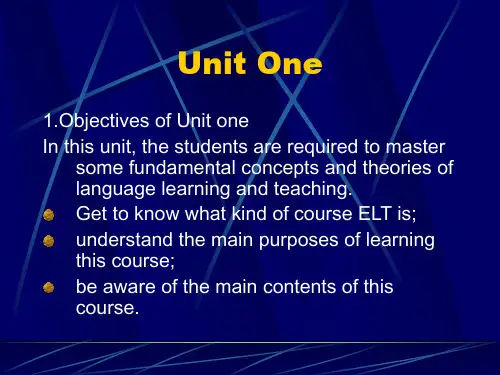

王蔷《英语教学法教程(第二版)》讲义Unit1Language and Language LearningUnit2Communicative Principles and Task-based Language Teaching Unit3The National English CurriculumUnit4Lesson PlanningUnit5Classroom ManagementUnit6Teaching PronunciationUnit7Teaching GrammarUnit8Teaching VocabularyUnit9Teaching ListeningUnit10Teaching SpeakingUnit11Teaching ReadingUnit12Teaching WritingUnit13Integrated SkillsUnit14Moral LearningUnit15Assessment in Language TeachingUnit16Learner Differences and Learner TrainingUnit17Using and Creating ResourcesUnit18Evaluating and Adapting Textbooks语言和语言学习【考情分析】本章主要讨论语言观和语言学习观、优秀教师的基本素养以及如何成为一名优秀的英语教师。
主要考点:结构主义、功能主义和交互语言理论;行为主义、认知主义、建构主义和社会建构主义学习理论;一个好的语言老师必备的素养;教师专业技能发展等。
【知识框架】Unit1 Language and Language Learning Views on languageViews in generalA good language teacherFunctional viewBehaviourist theoryCognitive theoryConstructivist theorySocio-constructivist theoryInteractional viewHow can one becomea good language teacher?An overview of the bookethic devotionprofessional qualitiespersonal stylesStage1Language trainingStage2Learning,practiceand reflectionGoal语言和语言学习1.1How do we learn languages?We learn language at different agesPeople have different experiencesPeople learn languages for different reasonsPeople learn languages in different waysPeople have different understandingsPeople have different capabilities in language learningLearning can be affected by the way how language is taughtLearning is affected by the degree of success one is expect to achieve.Thus the challenge confronting language teaching is how teaching methodology can ensure successful learning by all the learners who have more differences than the commonality.1.2Views on languageIn the past century,language teaching and learning practice has been influenced by three different views of language,namely,the structural view,the functional view and the interactional view.(1)The structural view of language结构主义语言观The structural view of language sees language as a linguistic system made up of various subsystem(Larsen-Freeman&Long,1991):the sound system(phonology音系学);the discrete units of meanings produced by sound combinations(morphology形态学/词汇学),and the system of combining units of meaning for communication (syntax句法学).Each language has a finite number of such structural items.结构主义语言观:结构主义语言观将语言看作由许多子系统组成的语言学系统(Larsen-Freeman&Long,1991):语音系统(音系学);产生于语音集合的意义的离散单位(形态学),以及交际意义的集合单元系统(句法学)。
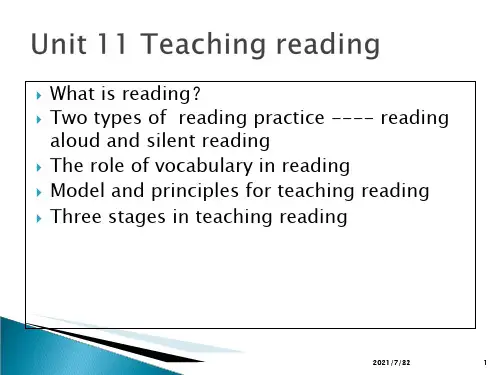
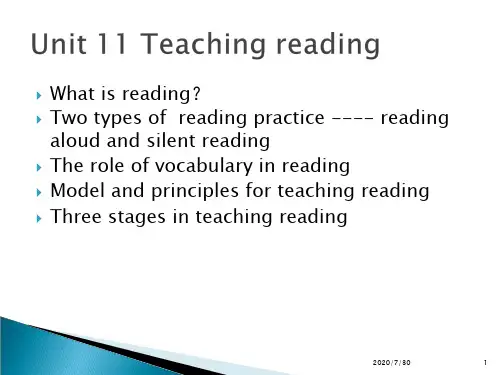
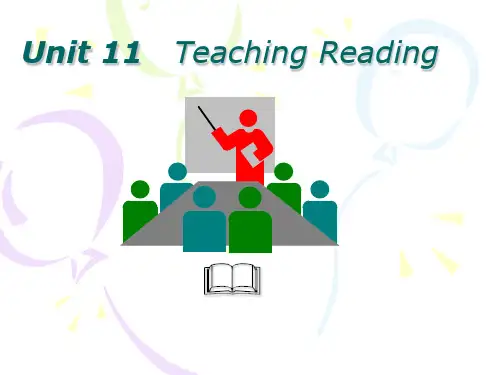
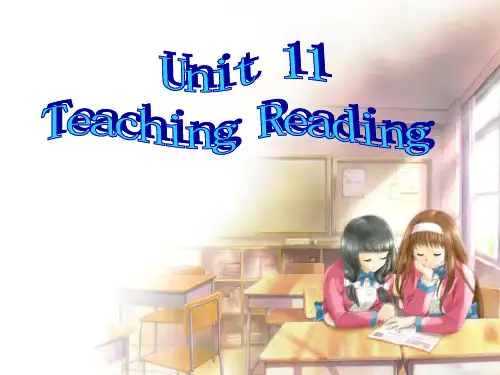
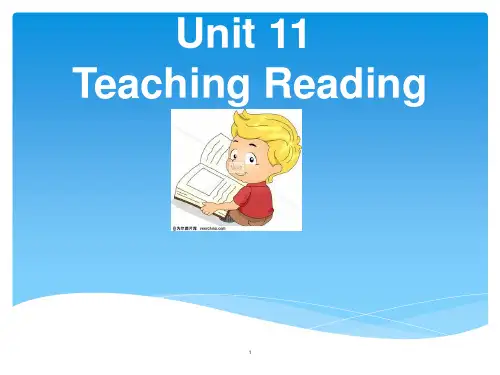
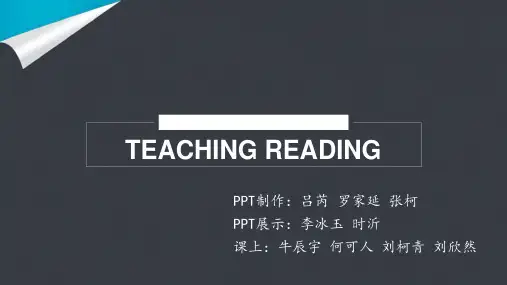
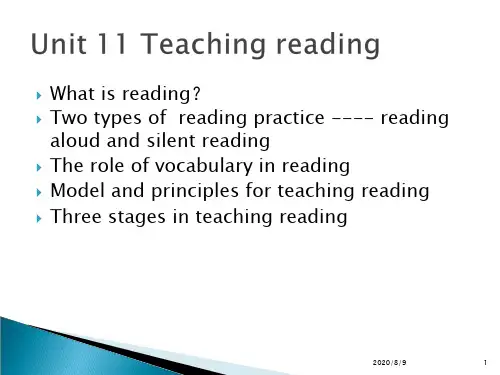
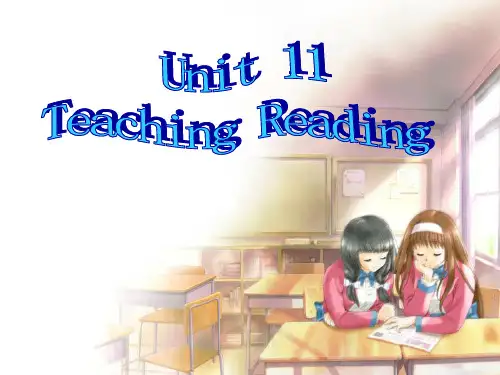
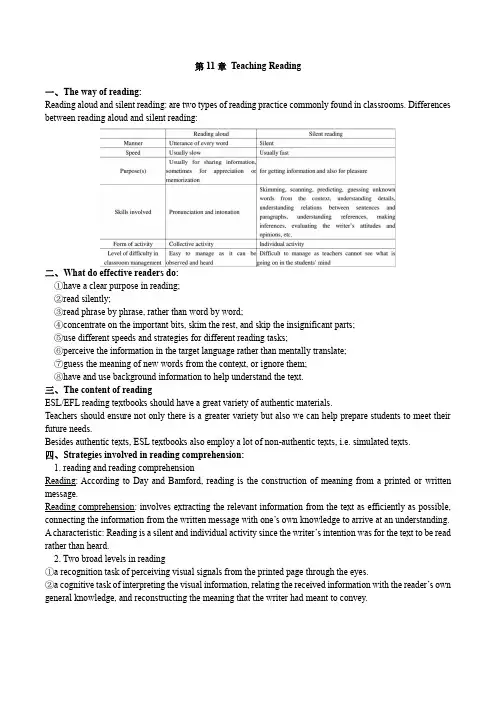
第11章Teaching Reading一、The way of reading:Reading aloud and silent reading: are two types of reading practice commonly found in classrooms. Differences between reading aloud and silent reading:二、What do effective readers do:①have a clear purpose in reading;②read silently;③read phrase by phrase, rather than word by word;④concentrate on the important bits, skim the rest, and skip the insignificant parts;⑤use different speeds and strategies for different reading tasks;⑥perceive the information in the target language rather than mentally translate;⑦guess the meaning of new words from the context, or ignore them;⑧have and use background information to help understand the text.三、The content of readingESL/EFL reading textbooks should have a great variety of authentic materials.Teachers should ensure not only there is a greater variety but also we can help prepare students to meet their future needs.Besides authentic texts, ESL textbooks also employ a lot of non-authentic texts, i.e. simulated texts.四、Strategies involved in reading comprehension:1. reading and reading comprehensionReading: According to Day and Bamford, reading is the construction of meaning from a printed or written message.Reading comprehension: involves extracting the relevant information from the text as efficiently as possible, connecting the information from the written message with one’s own knowledge to arrive at an understanding.A characteristic: Reading is a silent and individual activity since the writer’s intention was for the text to be read rather than heard.2. Two broad levels in reading①a recognition task of perceiving visual signals from the printed page through the eyes.②a cognitive task of interpreting the visual information, relating the received information with the reader’s own general knowledge, and reconstructing the meaning that the writer had meant to convey.3. The skills involved in reading: reading strategies五、The role of vocabulary in readingA large majority of students believe that vocabulary is the main obstacle in learning to read and this has already been pointed out by Grabe.The lack of such vocabulary may be the greatest single impediment of fluent reading.Fluent reading depends on an adequate sight vocabulary, a general knowledge about the target language, some knowledge about the topic, wide knowledge about the world and enough knowledge about text types. According to Day and Bamford, efficient reading begins with a lightening-like automatic recognition of words. This initial process of accurate, rapid and automatic recognition of vocabulary frees one’s mind to use other resources.Less the 3% of new words in a reading text will enable smooth, meaningful and enjoyable reading. Therefore, helping students to develop the ability of automatic word recognition is the basis for developing their reading skills.Sight vocabulary: words that one is able to immediately recognize with both sounds and meanings without special effort from the brainThe best and easiest way to develop sight vocabulary is to read extensively.Through intensive and extensive reading;Keeping a vocabulary notebook;Using a dictionary;However, the materials chosen must be at the right level and a degree of monitoring should be available to keep the motivation high so that students can feel a sense of achievement by sharing their reading experiences with others.六、Principles and models for teaching reading1. Principles for teaching reading:1) The selected texts and attached tasks should be accessible to the students.2) Tasks should be clearly given in advance.3) Tasks should be designed to encourage selective and intelligent reading for the main meaning rather than test the students’ understanding of trivial details.4) Tasks should help develop student’s reading skills rather than test reading comprehension.5) Develop student’s reading strategies and reading ability in general.6) Provide enough guidance at the beginning and help them become independent reader eventually.2. Models of teaching reading(1)Bottom-up modelThe way one teaches reading always reflects the way one understands reading and the reading process. Some teachers teach reading by introducing new vocabulary and new structures first and then going over the text sentence by sentence. This is followed by some questions and answers and reading aloud practice.Reading comprehension is based on the understanding and mastery of all the new words, new phrases, and new structures as well as a lot of reading aloud practice.In reading, information is transmitted along a linear process: letters—words—phrases—clauses—sentences—paragraphs—whole discourse.(2)Top-down model -- Schema theoryBottom-up model believes that one’s background knowledge plays a more important role than new words and new structures in reading comprehension.Teaching process: the teacher should teach the background knowledge first so that students equipped with such knowledge will be able to guess meaning from the printed page.Reading process: a psycholinguistic guessing game(Goodman, 1970).(3)Interactive modelThe current theory views reading as an interactive process.Reading comprehension is based on the interactive process between visual information obtained from the reading materials and the readers’ prior knowledge.Reading process: brain receives visual information and at the same time, interprets or reconstructs the meaning the writer had in mind when he wrote the text. This process does not only involve the printed page but also the reader’s knowledge of the language in general, of the world, and of the text types.七、Reading activitiesThe three stages are pre-reading, while-reading, and post-reading.1. Pre-reading activities(1) Definition of pre-reading activitiesPre-reading activities refer to tasks/activities that students do before they read the text in detail.(2) Purpose:To stimulate students’ interests, to facilitate while-reading activities. By:①pooling existing knowledge about the topic;②predicting the contents of the text;③skimming or scanning the text or parts of the text for certain purposes;④learning key words and structures.To sum up, the purpose is to prepare the students linguistically, thematically and affectively for the tasks in while-reading activities.(3) Pre-reading activities in details:1) Predicting—confirm or reject prediction in readingPredicting will get the mind close to the theme of the text to be read, making reading more intriguing and purposeful and resulting in better comprehension compared with the situation where the learner starts reading with a blank mind.Predictions can be done in many different ways①Predicting based on the title;②Predicting based on vocabulary;③Predicting based on the T/F questions.2) Setting the scene1) Aim: get the students familiarized with the cultural and social background knowledge relevant to the reading text.2) Ways of setting the scene:①Discussing culture-bound aspects of the text;②Relating what students know to what they want to know, and then ask the students to read the text to see if they can find what they want to know;③Using visual aids to set the scene.3) SkimmingIt means to read quickly to get the gist.4) ScanningReading for specific information, and should ignore the irrelevant parts when reading.2. While-reading activitiesThere are two ways of exploiting texts:1) Focusing on the results of reading:Multiple-choice questions; T/F; open questions, paraphrasing, translation.2) Focusing on the process of understanding:①Information transfer activities:When information in text form is transferred to another form , it can be more effectively processed and retained. Information transfer activities: The way to transfer information from one form to another is called a transition device.Purposes of transition deviceWhen using transition devices, we need to ensure that it is an appropriate form to encapsulate the main information contained in the text. We need to bear in mind the purposes of transition devices.①Focus attention on the main meaning of the text②Be able to simplify sophisticated input so that it becomes the basis for output;③Allow students to perform tasks while they are reading;④Highlight the main structural organization of a text/part of a text, and show how the structure relates to meaning;⑤Involve all the students in clearly defined reading tasks;⑥Precede one step at a time and students should do easier tasks before doing more complicated ones;⑦When a TD is completed, use it as a basis for further oral or written language practice.②Reading comprehension questionsNuttall’s classification of reading questions①Questions of literal comprehension;②Questions involving reorganization or reinterpretation;③Questions for inferences;④Questions for evaluation or appreciation;⑤Questions for personal response.③Understanding referencesAll natural language, spoken or written, uses referential words such as pronouns to refer to people or things already mentioned previously in the context. Understanding what these words refer to is crucial forcomprehension.④Making inferencesIt requires the reader to use background knowledge in order to infer the implied meaning of the author. Making inferences is actually the process of relating the given information to what we have known about the world. 3. Post-reading Activities(1) Objectives①To check the fulfillment of reading tasks;②To evaluate the application of reading strategies;③To apply what has been learned;④To integrate reading with other skills.(2) RequirementsPost-reading tasks should provide the students with opportunities to relate what they have read to what they already know or what they feel.Post-reading tasks should enable students to produce language based on what they learned.(3) Types of post-reading activitiesRole play, Gap-filling, Discussion, Retelling and Writing.。
第11章Teaching Reading一、The way of reading:Reading aloud and silent reading: are two types of reading practice commonly found in classrooms. Differences between reading aloud and silent reading:二、What do effective readers do:①have a clear purpose in reading;②read silently;③read phrase by phrase, rather than word by word;④concentrate on the important bits, skim the rest, and skip the insignificant parts;⑤use different speeds and strategies for different reading tasks;⑥perceive the information in the target language rather than mentally translate;⑦guess the meaning of new words from the context, or ignore them;⑧have and use background information to help understand the text.三、The content of readingESL/EFL reading textbooks should have a great variety of authentic materials.Teachers should ensure not only there is a greater variety but also we can help prepare students to meet their future needs.Besides authentic texts, ESL textbooks also employ a lot of non-authentic texts, i.e. simulated texts.四、Strategies involved in reading comprehension:1. reading and reading comprehensionReading: According to Day and Bamford, reading is the construction of meaning from a printed or written message.Reading comprehension: involves extracting the relevant information from the text as efficiently as possible, connecting the information from the written message with one’s own knowledge to arrive at an understanding.A characteristic: Reading is a silent and individual activity since the writer’s intention was for the text to be read rather than heard.2. Two broad levels in reading①a recognition task of perceiving visual signals from the printed page through the eyes.②a cognitive task of interpreting the visual information, relating the received information with the reader’s own general knowledge, and reconstructing the meaning that the writer had meant to convey.3. The skills involved in reading: reading strategies五、The role of vocabulary in readingA large majority of students believe that vocabulary is the main obstacle in learning to read and this has already been pointed out by Grabe.The lack of such vocabulary may be the greatest single impediment of fluent reading.Fluent reading depends on an adequate sight vocabulary, a general knowledge about the target language, some knowledge about the topic, wide knowledge about the world and enough knowledge about text types. According to Day and Bamford, efficient reading begins with a lightening-like automatic recognition of words. This initial process of accurate, rapid and automatic recognition of vocabulary frees one’s mind to use other resources.Less the 3% of new words in a reading text will enable smooth, meaningful and enjoyable reading. Therefore, helping students to develop the ability of automatic word recognition is the basis for developing their reading skills.Sight vocabulary: words that one is able to immediately recognize with both sounds and meanings without special effort from the brainThe best and easiest way to develop sight vocabulary is to read extensively.Through intensive and extensive reading;Keeping a vocabulary notebook;Using a dictionary;However, the materials chosen must be at the right level and a degree of monitoring should be available to keep the motivation high so that students can feel a sense of achievement by sharing their reading experiences with others.六、Principles and models for teaching reading1. Principles for teaching reading:1) The selected texts and attached tasks should be accessible to the students.2) Tasks should be clearly given in advance.3) Tasks should be designed to encourage selective and intelligent reading for the main meaning rather than test the students’ understanding of trivial details.4) Tasks should help develop student’s reading skills rather than test reading comprehension.5) Develop student’s reading strategies and reading ability in general.6) Provide enough guidance at the beginning and help them become independent reader eventually.2. Models of teaching reading(1)Bottom-up modelThe way one teaches reading always reflects the way one understands reading and the reading process. Some teachers teach reading by introducing new vocabulary and new structures first and then going over the text sentence by sentence. This is followed by some questions and answers and reading aloud practice.Reading comprehension is based on the understanding and mastery of all the new words, new phrases, and new structures as well as a lot of reading aloud practice.In reading, information is transmitted along a linear process: letters—words—phrases—clauses—sentences—paragraphs—whole discourse.(2)Top-down model -- Schema theoryBottom-up model believes that one’s background knowledge plays a more important role than new words and new structures in reading comprehension.Teaching process: the teacher should teach the background knowledge first so that students equipped with such knowledge will be able to guess meaning from the printed page.Reading process: a psycholinguistic guessing game(Goodman, 1970).(3)Interactive modelThe current theory views reading as an interactive process.Reading comprehension is based on the interactive process between visual information obtained from the reading materials and the readers’ prior knowledge.Reading process: brain receives visual information and at the same time, interprets or reconstructs the meaning the writer had in mind when he wrote the text. This process does not only involve the printed page but also the reader’s knowledge of the language in general, of the world, and of the text types.七、Reading activitiesThe three stages are pre-reading, while-reading, and post-reading.1. Pre-reading activities(1) Definition of pre-reading activitiesPre-reading activities refer to tasks/activities that students do before they read the text in detail.(2) Purpose:To stimulate students’ interests, to facilitate while-reading activities. By:①pooling existing knowledge about the topic;②predicting the contents of the text;③skimming or scanning the text or parts of the text for certain purposes;④learning key words and structures.To sum up, the purpose is to prepare the students linguistically, thematically and affectively for the tasks in while-reading activities.(3) Pre-reading activities in details:1) Predicting—confirm or reject prediction in readingPredicting will get the mind close to the theme of the text to be read, making reading more intriguing and purposeful and resulting in better comprehension compared with the situation where the learner starts reading with a blank mind.Predictions can be done in many different ways①Predicting based on the title;②Predicting based on vocabulary;③Predicting based on the T/F questions.2) Setting the scene1) Aim: get the students familiarized with the cultural and social background knowledge relevant to the reading text.2) Ways of setting the scene:①Discussing culture-bound aspects of the text;②Relating what students know to what they want to know, and then ask the students to read the text to see if they can find what they want to know;③Using visual aids to set the scene.3) SkimmingIt means to read quickly to get the gist.4) ScanningReading for specific information, and should ignore the irrelevant parts when reading.2. While-reading activitiesThere are two ways of exploiting texts:1) Focusing on the results of reading:Multiple-choice questions; T/F; open questions, paraphrasing, translation.2) Focusing on the process of understanding:①Information transfer activities:When information in text form is transferred to another form , it can be more effectively processed and retained. Information transfer activities: The way to transfer information from one form to another is called a transition device.Purposes of transition deviceWhen using transition devices, we need to ensure that it is an appropriate form to encapsulate the main information contained in the text. We need to bear in mind the purposes of transition devices.①Focus attention on the main meaning of the text②Be able to simplify sophisticated input so that it becomes the basis for output;③Allow students to perform tasks while they are reading;④Highlight the main structural organization of a text/part of a text, and show how the structure relates to meaning;⑤Involve all the students in clearly defined reading tasks;⑥Precede one step at a time and students should do easier tasks before doing more complicated ones;⑦When a TD is completed, use it as a basis for further oral or written language practice.②Reading comprehension questionsNuttall’s classification of reading questions①Questions of literal comprehension;②Questions involving reorganization or reinterpretation;③Questions for inferences;④Questions for evaluation or appreciation;⑤Questions for personal response.③Understanding referencesAll natural language, spoken or written, uses referential words such as pronouns to refer to people or things already mentioned previously in the context. Understanding what these words refer to is crucial forcomprehension.④Making inferencesIt requires the reader to use background knowledge in order to infer the implied meaning of the author. Making inferences is actually the process of relating the given information to what we have known about the world. 3. Post-reading Activities(1) Objectives①To check the fulfillment of reading tasks;②To evaluate the application of reading strategies;③To apply what has been learned;④To integrate reading with other skills.(2) RequirementsPost-reading tasks should provide the students with opportunities to relate what they have read to what they already know or what they feel.Post-reading tasks should enable students to produce language based on what they learned.(3) Types of post-reading activitiesRole play, Gap-filling, Discussion, Retelling and Writing.。